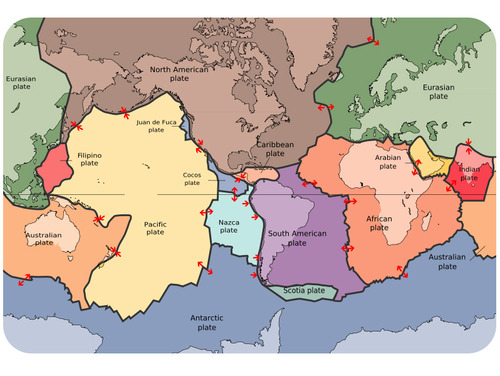
Photo Courtesy: Phil Stoffer
Our planet was very different some 250 million years ago from what it looks like today. Earth is the only planet that has plate tectonics because no other world has a surface divided into plates. Planet earth is constantly changing. Earth’s crust (lithosphere) consists of 15 to 20 moving tectonic plates. Even imagine these plates like a piece of cracked shell that lies on a hot, molten rock of Earth’s fits snugly against each other. The heat from the radioactive process within the planet’s interior causes the plates to move; it causes earth masses to move towards and away from each other at an average rate of 0.6 inches per year. This movement of tectonic plates is called tectonic shift.
Platonic plates are crucial for the existence of life on Earth because it would be a different place without them. Tectonic plates support the continuous recycling of Earth’s crust that plays a vital role in providing suitable climate, minerals, oil deposition, and oceans that make possible life on this planet by producing averages and balance temperature on the Earth.

Earlier, there was only one ocean called Panthalassa and only one continent called Pangaea. Earth mantle heated and cooled over many millennia, resulting in the broken outer crust and commencing the plate motion that is continuous still today. That huge continent eventually broke apart, creating new and ever-changing land masses and oceans.
Earth is divided into seven different continents from largest to smaller like, Asia, Africa, North America, South America, Antarctica, Europe, and Australia. Continents make up most of the Earth’s land surface, excluding islands; they are not considered a part of continents.
Theory of plate tectonics
The concept of plate tectonics was first formulated in the 1960s. According to this theory, Earth has a rigid outer layer called the lithosphere, which is almost 100km thick, and it overlies a molten layer called the asthenosphere.
The lithosphere is broken up into seven large continental and ocean-sized plates, six or seven medium-sized regional plates with various smaller ones. Nicholas van der Elst, a seismologist, considers the plate tectonics theory as a ‘unifying geology theory. Van der Elst also said that people used to make assumptions about the Earth’s continuous reforming process until plate tectonics theory came to light.
After decades of collecting mapping ocean sonar data, EVen, in 1977, scientists began to see an accurate picture of the seafloor’s emergence. Today Science has proved that the surface of Earth is in a constant state of change. We can observe that mountains are rising and eroding, volcanoes erupting, oceans expanding, shrinking, and striking earthquakes.
According to the theory, the Earth’s lithosphere comprises a mosaic of rigid plates that are in relative motion. The process of plate tectonics affects humans in several ways:
• It causes volcanoes to erupt
• It causes an earthquake
• It causes the recycling of elements within the biosphere and also between the geo and biosphere.
• It causes the rising of mountains.
Have you ever imagined how the Earth would be like without plate tectonics? There would be few earthquakes, less volcanism, no deep-sea trenches, and very few mountains. Our Earth is unique in several ways- from having an abundance of life, water, and continuous renewal of surface by plate tectonic process.
During the late 20s and early 21 centuries, it has become apparent that the plate-tectonic process influences the composition of the Earth’s atmosphere and oceans. It serves as a primary cause of climate change and contributes to the physical and chemical environment in which life evolves.
The Earth’s outer shell is divided into large slabs, known as ‘plates’ that glide over the mantle. Even this movement is relatively slow, around 1-2 inches per year.
HOW THESE PLATES WORK AND WHY DOES EARTH HAVE THEM?
According to the theory, the massive lithospheric plates move in different directions, and the way they interact with each other has an immense impact on Earth. The points where these plates meet are called ‘boundaries’; there are three kinds of boundaries.
- Convergent boundaries (it occurs when two plates move towards each other)
- Transform boundaries (it occurs when two plates are sliding past one another)
- Divergent boundaries (it occurs when plates are moving away from each other)
Earth crust crumbles at the place where these boundaries meet, resulting in the formation of mountain ranges.
FINAL THOUGHTS
Plate tectonics is the excellent, unifying theory of Earth sciences. The continental drift and seafloor concepts spread into one holistic approach that defines many major structural features of the Earth’s surface. The explanation is that the oceanic lithosphere is never older than about 180 Ma and only the continents have preserved the geological record. Plate tectonics is one of the many factors that influence life on Earth. Maybe it affects life because it is one of the reasons why evolution started on Earth.
Sources:
- https://www.britannica.com/science/plate-tectonics
- https://courses.lumenlearning.com/wmopen-geology/chapter/outcome-theory-of-plate-tectonics/
- https://en.wikipedia.org/wiki/Plate_tectonics
- https://www.open.edu/openlearn/science-maths-technology/science/geology/plate-tectonics/content-section-5.4














